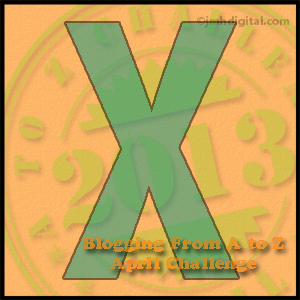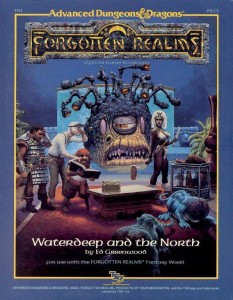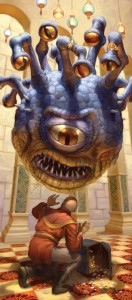 In September 2012, I had two articles published in Dungeon Magazine issue 206. The first article was called “The Xanathar: Beholder Crime Lord of Waterdeep” and in it I provided a new take on one of Waterdeep’s most infamous criminals. The second was an adventure called “Eyes on the Ball” in which the PCs found themselves forming a tenuous allegiance with The Xanathar and his lieutenants to stop an evil slaver.
In September 2012, I had two articles published in Dungeon Magazine issue 206. The first article was called “The Xanathar: Beholder Crime Lord of Waterdeep” and in it I provided a new take on one of Waterdeep’s most infamous criminals. The second was an adventure called “Eyes on the Ball” in which the PCs found themselves forming a tenuous allegiance with The Xanathar and his lieutenants to stop an evil slaver.
Today I’d like to share some of the background and insights that inspired my re-imagining of The Xanathar. But in order to do that I need to first provide some context. It all began in 1987.
Throughout April Dungeon’s Master is participating in the Blogging from A to Z Challenge. The challenge is to write a new article ever day in April, excluding Sundays. That’s 26 articles over the course of the month. To make things even more interesting the title of each article will begin with a different letter of the alphabet. Today the “X” is for Xanathar, the name of the most notorious crime boss in the Forgotten realms and my part in adding to the canon of D&D.
The first time I laid eyes on The Xanathar I was 13. I picked up the Forgotten Realms source book called Waterdeep and the North and there on the cover was a Beholder along with an eclectic mix of monsters and men. I was fascinated. This was supposed to be a book about the City of Splendors yet this cover didn’t seem to reflect that. I was intrigued and curious so I bought the book; I had to know who this Beholder was and why he was featured so prominently on the cover.
 Reading though Waterdeep and the North I discovered that this Beholder was called The Xanathar, and that he was the biggest crime boss in Waterdeep. In a city that was known for secret lords, and strongly enforced law and order I was even more interested in this Beholder now that I knew he ran a criminal syndicate secretly, from the shadows, right under the noses of some of the most powerful figures in the Realms.
Reading though Waterdeep and the North I discovered that this Beholder was called The Xanathar, and that he was the biggest crime boss in Waterdeep. In a city that was known for secret lords, and strongly enforced law and order I was even more interested in this Beholder now that I knew he ran a criminal syndicate secretly, from the shadows, right under the noses of some of the most powerful figures in the Realms.
Although The Xanathar was only mentioned on a few pages, he quickly became one of my favourite characters in Waterdeep. Yet I wasn’t sure how to use him as more than a one-time villain of the week that the PCs would likely kill and then forget. So I waited. A year later the boxed set City System was released. It had 10 full colour poster maps that connected to form a giant map of Waterdeep. With this new resource I was ready to begin a long term campaign set exclusively in Waterdeep. I finally had a chance to use The Xanathar and his thieves’ guild in my home adventure as reoccurring villains.
The campaign was relatively simple. Every player created a character that was some kind of Thief. They were being groomed to become members of a newly forming thieves’ guild but they first had to prove their worth over time. They were scored by the would-be Guild Master based on how much they earned. When the time came to form the guild their ranking in the guild would be based in large part on how much they’d accumulated and how many points they’d earned. This campaign ran for three years of real time and around 15 levels in game.
During those three years the PCs had chances to work with and fight against The Xanathar and his people. They didn’t initially know who The Xanathar was, but they heard rumours. During the climax of the adventure the PCs had to decide if they would form a new thieves’ guild as they’d planned all along or if they’d rather follow The Xanathar. By this time they’d killed all of his lieutenants so he had some vacancies in his guild. They decided to kill the Beholder and in the end opted not to form the guild at all. After all they were heroes and didn’t want to be crime bosses. They cleaned up the underbelly of Waterdeep and decided to leave the city and see what else the Realms had to offer.
 That campaign was one of my all time favourites. We spent so much time creating and developing the characters that they were almost real to us. The Xanathar and his organization featured so prominently in that campaign that I felt that I’d become a part of it. I knew this group, how they operated, what their goals were, and most importantly how they’d continue if The Xanathar was ever killed. For years after we ended that campaign I always wished I’d had the chance to return to it. And in 2011 I finally did.
That campaign was one of my all time favourites. We spent so much time creating and developing the characters that they were almost real to us. The Xanathar and his organization featured so prominently in that campaign that I felt that I’d become a part of it. I knew this group, how they operated, what their goals were, and most importantly how they’d continue if The Xanathar was ever killed. For years after we ended that campaign I always wished I’d had the chance to return to it. And in 2011 I finally did.
Wizards of the Coast contacted some freelance writers and provided a list of topics they wanted to run in upcoming Dragon Magazine and Dungeon Magazine. When I saw The Xanathar listed as a topic I immediately requested it. This was going to be my chance to go back to that campaign I spent so much time fleshing out as a teenager all those years ago. By writing this article I could share some of the magic that so enthralled me with these characters.
I’d always felt that the strength of The Xanathar was the name. It stood to reason that any Beholder could call itself The Xanathar and take on the job of crime boss. After all, the Beholder was so secretive anyway that only a select few individuals ever spent time near the real creature. Those who did were likely not going to be able to tell the difference between two Beholders – no one stares at a creature that always stares back at you with multiple eyes.
I decided to take a page from The Princess Bride. In that movie the Dread Pirate Roberts had a fierce reputation, but over time the man behind the mask retired and passes on his mantle to a worthy successor. I didn’t see any reason why this couldn’t work for a Beholder crime boss. Wherever a new Xanathar came to power it would only need to replace a few top lieutenants, have them refer to the new Beholder as The Xanathar and voila, the legend is preserved. This was an easy way to explain how The Xanathar from AD&D 2e was still around for 4e D&D.
When it came time to create a new syndicate to help this replacement Xanathar run things I took the characters from my home campaign and used them as the templates for The Xanathar’s new lieutenants. Here’s how the final characters were inspired by the originals.
- Kal’dir (Drow)
Originally a Half-elf named Calder, this was Wimwick’s character. He began as a scout and combat expert. He wasn’t really interested in picking pockets or opening locks. He was more interested in the Rogue’s combat abilities. He was strong, well built, and excelled at backstabbing. He used a short sword and dagger in combat and knew how to use the shadows and terrain to his advantage. Later in the camping he rescued a Drow prisoner. The old Elf agreed to teach Calder how to fight like a Drow as repayment or his freedom. By the end of the campaign the PC was a Thief 10/Fighter 5. When I wrote the article I decided that making Calder a Drow from the outset was a better fit.
- Quid (Elf)
This character needed very little adjusting. He was one of the best pick pockets around. He had an affinity for small shiny things and would take enormous risks to acquire rare gem stones. Early in the campaign he acquired a Frost Brand dagger and it became his trademark. After a year the player decided the he wanted Quid to dabble in magic (something old school Thief could do). Eventually he bought or stole spell books, scrolls and magic items that would help him teach himself wizardry. By the end of the camping he was a Thief 10/Wizard 5.
With so many new class options available in 4e it made more sense that Quid be reimaged as a Sorcerer (a class that didn’t exist in 2e). This played to his high Dexterity and Charisma. I liked the idea of keeping his frost dagger as his implement so that detail remained.
- Sail Sapphire (Half-Elf)
This “she” was original a “he” named Starr Sapphire. He was a more hands on thief than the rest of the group. He was a master pick pocket and liked to get up close and personal. He was always wearing disguises and getting into parties he had no business being at. He was a ladies man who only slept alone when he wanted to. He eventually started a relationship with twin sisters, both clerics of Mask. When they both became pregnant around the same time he took this as a sign of Mask’s favour and began studying Mask’s ways. The guild master always liked Starr and saw a bit of himself in the young Thief. Starr was clearly his favourite and he often sent him on special solo assignments. In truth, the player running Starr had more free time to play than the others which is why he became the favourite. By the end of the campaign he was a Thief 12/Cleric 3.
When I wrote the article I began by changing the character’s sex to female. I liked the idea of a female spy better than a male James Bond rip off. I completely dropped any elements of divine affiliation but kept the idea the she was The Xanathar’s favourite. Changing the name from Starr to Sail was the only significant edit Wizards made to my article.
- Draak (Dragonborn)
This was the only completely original character I made up for the article. I knew that the guild needed someone strong and fierce to represent The Xanathar’s slaving interests. Having played a Dragonborn from level 1-25 in 4e I felt I had a pretty good understanding of the race. Since creating Draak for this article I’ve used him as an NPC in my home games. He’s proving to be every bit as interesting as I imagined he would be.
- Arizza (Elf)
Originally a much bigger part of our party and once called Kim A’Riszza, she was an NPC I ran as part of the camping. She was smart and secretive. She was a Wizard with an affinity for languages and puzzles. She had a sharp mind and never seemed to forget details. She wasn’t an adventurer like the others, but she had an extensive network of contacts throughout Waterdeep. She was the record keeper for the contest and kept score of everyone’s earnings. She was responsible for keeping the ill gotten gains secret and helped fence goods for the guild. I always envisioned her as about 5 levels behind the main party.
When it came time to write the article I realized that she didn’t need to be a big part of the organization. I shifted some of her responsibilities to other lieutenants and reduced her role greatly. I still see her as more of a personal aid to The Xanathar. I think that she’s probably the one who sticks around when there’s a regime change and calls the new Beholder Xanathar.
Wiring The Xanathar article for Wizards is one of my proudest accomplishments as a gamer, a blogger and a writer. It was the first time I was paid to do something D&D and I got to contribute to the cannon of the game I enjoy so much. I hope that you enjoyed reading my article and I hope you find these insights into the origins of the characters helpful. I think The Xanathar article was some of the best work I’ve ever done. I imagine that other gamers have used these ideas and these characters in their game and have had as much fun with them as I have over the years.
Visit the Wizard of the Coast website and download a copy of my article The Xanathar and my adventure Eyes on the Ball. You need a valid DDI subscription to access these articles.
 Looking for instant updates? Subscribe to the Dungeon’s Master feed!
Looking for instant updates? Subscribe to the Dungeon’s Master feed!
2 replies on “The Xanathar”
This is a great post. I love the background on how you got interested in your article and some of the behind the scenes information.
On my current Neverwinter campaign, we used your material as base for the background of a character (that belongs to the Xanathar).
Im also thinking about changing the beholder that exists in that campaign setting to a more Xanathar-like one, and adapting your adventure to run in Neverwinter.
Thks for this article and the ones in Dungeon, very good ones indeed.